Imagine diving into a world where fish stroll alongside you on land—sounds like something out of a sci-fi movie, right? Well, brace yourself because in the vast and diverse kingdom of over 30,000 fish species, some have taken the phrase “a fish out of water” to a whole new level. Yes, you read that correctly. Some fish have evolved to have legs, or at least, leg-like appendages that let them wander on terra firma as if they’re going for a casual walk in the park.
Now, I know what you’re thinking: “Fish with legs? Are you pulling my fin?” It seems far-fetched, but our planet is home to some truly incredible species that blur the line between aquatic and terrestrial life.
In this guide, I’m taking you on a tour of more than 15 astonishing fish that have developed the ability to “walk” on land, thanks to their unique anatomical quirks. From the muddy shores to the dense underbrush, these fish are the real deal, showing off their land-roaming capabilities.
So, let’s dive in and explore these fascinating creatures together. Trust me, it’s going to be a journey filled with “oohs,” “aahs,” and plenty of “wait, what?” moments. Let the adventure begin!
Contents
15+ Popular fish with legs
Here is a list of 15+ popular fish that have legs or other limbs that can help them walk in the water. Some of these popular fish with legs are extinct while most of them are currently in existence.
Also read:
1. Warty Frogfish
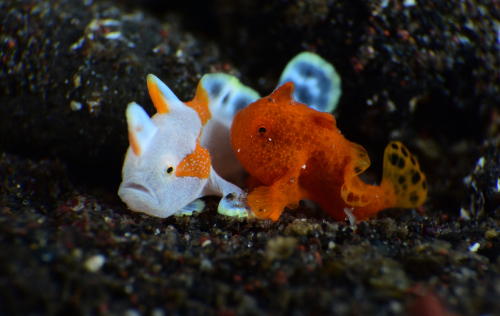
- Scientific name: Antennarius maculatus
- Diet: is a carnivore and primarily feeds on smaller animals and fish
The warty frogfish is also known as the clown frogfish. This marine fish has a highly unique and distinct appearance. Like other frogfish, the warty frogfish also has the ability to change its color. The fish is typically found in the Indo-Pacific region and prefers coral reefs.
The pectoral fins, along with the pelvic fins, help the warty frogfish “walk” on the bottom. They also help keep the fish in a stable position when it’s hunting prey.
2. Red-lipped batfish
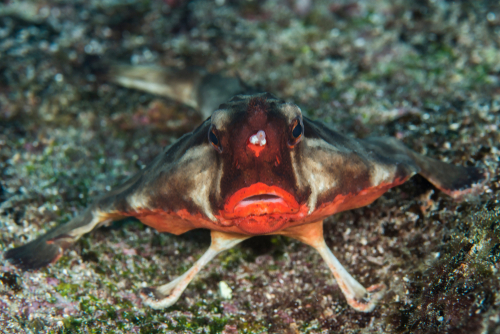
- Scientific name: Ogcocephalus darwini
- Diet: the fish is a piscivore and feeds primarily on crabs, shrimp, and worms
The red-lipped batfish is yet another unique fish that can use its fins to “walk” on the floor of the ocean. The fish has a very distinct appearance, including bright red lips and a light-brown body with a white belly.
The fish can grow up to a length of 40 cm and is typically found in waters near Galapagos Islands and off the coast of Peru. The red-lipped batfish can “walk” using its pelvic, pectoral, and anal fins which are specially adapted for this purpose.
3. Snakehead fish
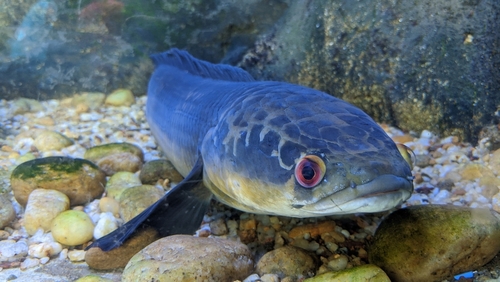
- Scientific name: Channidae
- Diet: typically feed on smaller fish, insect larvae, amphibians, crustaceans, as well as reptiles
Snakehead fish, or snakeheads, as they are more commonly known, are freshwater fish that are native to certain parts of Asia and Africa. These fish have elongated bodies, and large mouths, and have a pattern on their bodies similar to that of snakes.
This fish is considered an invasive species as they prey on smaller fish and other aquatic creatures. Some species of snakehead can reach up to 1 m in length.
4. Epaulette shark
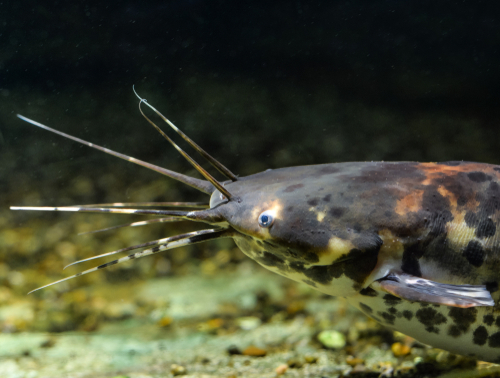
- Scientific name: Hemiscyllium ocellatum
- Diet: typically feeds on worms, crustaceans, and other small fish
The epaulette shark is yet another fish that has the ability to “walk”. The fish is found in the tropical waters off the coasts of New Guinea and Australia. The fish belongs to the Hemiscylliidae family and is a species of carpet shark.
With an average length of 1 m, the epaulette shark isn’t that big when it comes to size but it has the ability to “walk” using its fins.
5. West African lungfish
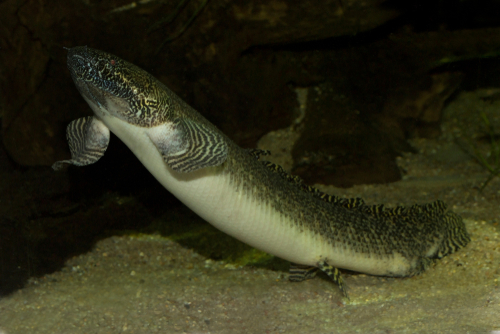
- Scientific name: Protopterus annectens
- Diet: mostly feeds on small fish, crabs, mollusks, and prawn
The West African lungfish is yet another fish with a unique appearance. The fish has been observed to walk on its lungs. While it doesn’t actually have legs, it can adapt its pelvic fins to slowly walk or glide.
This fish can reach up to about 1m in length and has a long body similar to that of an eel in many respects. The West African lungfish is a freshwater species that is found in freshwater bodies in western and central Africa.
6. Sea Robin
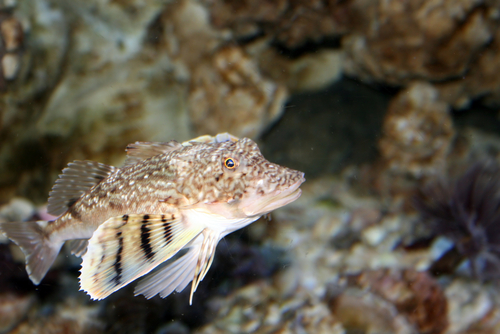
- Scientific name: Triglidae
- Diet: small fish, crabs, shrimp, etc.
Sea robins are unique species of fish that have brightly colored bodies and patterns on their pectoral fins. They can be found in tropical seas all over the world, typically in shallow waters.
Some physical characteristics of sea robins include elongated bodies, bony heads, as well as two dorsal fins. Sea robins can “walk” on the bottom using their feelers and pectoral fins. These structures are also known as “walking rays” and they help sea robins move in search of prey.
7. Walking Catfish
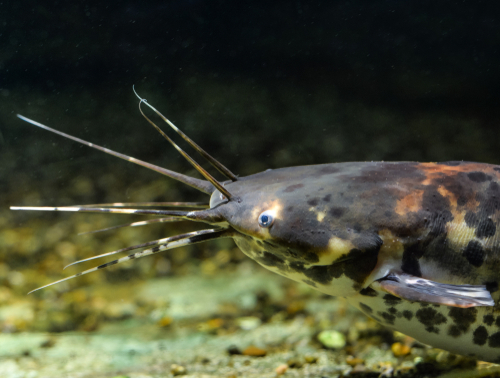
- Scientific name: Clarias batrachus
- Diet: are typically omnivores and feed on small fish, mollusks, and other types of invertebrates
The walking catfish is a unique fish that is freshwater species of catfish native to South Asian countries like Indonesia, Bangladesh, and Malaysia. The fish can grow up to 50 cm in length and has a long body that typically has a gray color. The body is also usually covered with small white spots.
As the name implies, the walking catfish can use its pectoral fins to “walk” on dry land in search of food.
8. West Indian Ocean coelacanth
- Scientific name: Latimeria chalumnae
- Diet: is a piscivore and feeds primarily on other fish species
The West Indian Ocean coelacanth is a beautiful, unique fish that was first scientifically recognized in 1938 when it was caught by a trawler. This fish is a deep-water marine fish that prefers underwater caves. It is usually found in the western Indian Ocean, particularly near the coast of South Africa.
The West Indian Ocean coelacanth can grow up to 2m in length and has an average weight of 80kg. Their body color is royal blue, with light spots.
9. Chinese Hillstream Loaches

- Scientific name: Beaufortia kweichowensis
- Diet: algae, worms, shrimps
The Chinese Hillstream loach, as the name implies, is a species of loach that is found in rivers across China. This freshwater species is also a popular choice for aquariums. In aquariums, the Chinese Hillstream loach needs very specific conditions to thrive.
This species of loach can grow up to 6 cm in length and is compatible with many other species of fish in aquariums. The Chinese Hillstream loach is also thought to use its fins to “walk” on the bottom of aquariums and water tanks.
10. Polypterus Lapradei
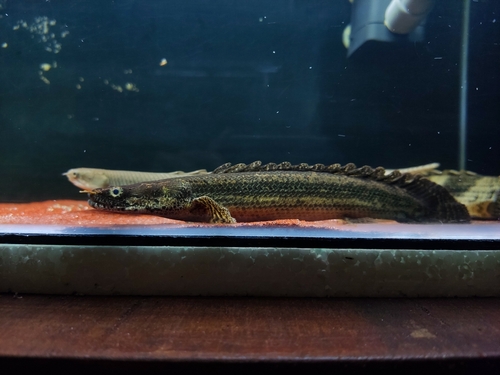
- Scientific name: Polypterus bichir lapradei
- Diet: piscivorous in nature, feeds on fish at the bottom
The Polypterus lapradei is a species of fish belonging to the Polypteridae family. It is a freshwater fish, endemic to the African continent. It can be found in several river systems and other freshwater bodies all over the continent.
This fish is large and can grow up to 76 cm in length on average. An interesting feature of the fish’s anatomy is the presence of strong pectoral fins, which allow it to move on dry land for short distances.
11. Mudskipper
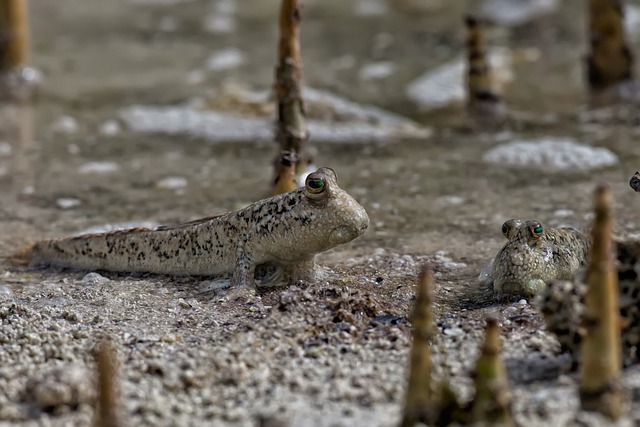
- Scientific name: Gobiidae
- Diet: feed primarily on crustaceans in addition to other small animals
The mudskipper is probably the most popular fish that has legs and can walk. More accurately, the mudskipper is an amphibious fish that has a distinct appearance and can survive both in and out of water.
Mudskippers can grow up to 30 cm in length and have a brown-green body color. The pectoral fins of a mudskipper are located under its body and help the fish move. These pectoral fins work in a similar fashion as legs.
12. Tiktaalik roseae
- Scientific name: Tiktaalik roseae
- Diet: exact diet is not currently known but it is thought to have preyed on smaller marine creatures
The tiktaalik roseae was a fish-like creature that inhabited Earth’s waters during the Late Devonian Period. The first intact fossils of the species were found in Canada in 2004, on Ellesmere Island.
From research conducted on the fossils of tiktaalik roseae, it has been determined that the fish had strong lower limbs that functioned like legs and allowed the creature to walk on the bottom of shallow waters. They would have also allowed it to move on land.
13. Panderichthys Rhombolepis
- Scientific name: Panderichthys Rhombolepis
- Diet: carnivore or piscivore
The Panderichthys Rhombolepis is another extinct fish species that is thought to have had the ability to move on land. This species, like the tiktaalik roseae, existed during the Late Devonian Period, over 350 million years ago.
The Panderichthys was a large fish about 1 meter in length. It had a large head like that of a tetrapod and had strong limbs that allowed it to move on land.
14. Red Gurnard
- Scientific name: Chelidonichthys cuculus
- Diet: typically feed on crustaceans and worms
The red gurnard is a marine species found in the eastern region of the Atlantic Ocean. It is also found in the Black Sea and the Mediterranean Sea. The red gurnard has a large head and a bright red body. The fish mostly feeds on crustaceans, mollusks, worms, and small fish.
The red gurnard can grow up to a length of 70 cm. The lower rays of the red gurnard’s pectoral fins are thin, finger-shaped organs that allow the fish to “walk” on the bottom and hunt prey.
15. Spotted Handfish
- Scientific name: Brachionichthys hirsutus
- Diet: small fish, shrimp, amphipods, and worms
The spotted handfish is a rare fish with an unusual body shape. The fish is native to south-eastern Australia and is usually found in water bodies such as the Derwent River estuary.
The fish can grow up to an average length of 12 cm and has an orange body with dark spots on it. The spotted handfish has pectoral fins that resemble legs or hands. Due to this, this fish prefers to ‘walk’ on its pectoral fins instead of swimming.
16. Climbing Gourami
- Scientific name: Anabas testudineus
- Diet: is an omnivore, feeds mostly on small fish and insects
The climbing gourami is a ray-finned family of fish that has over 30 species. It is primarily a freshwater fish found in freshwater bodies in Africa and Asia. The climbing gourami has an average length ranging from 10 cm to 30 cm.
They are called climbing fish due to their ability to swim up and breathe in oxygen from the air. While these fish haven’t been observed walking in the wild, researchers and scientists claim they can walk short distances.
Final thoughts
Legs aren’t a common anatomical feature of fish. While prehistoric fish gradually developed legs and other limbs as they evolved into land mammals, the majority of fish species in existence today don’t have legs or the ability to walk.
In this guide, we presented over 15 popular fish with the ability to “walk”. In most cases, these fish can walk by using their pectoral fins or other similar anatomical structures.
Frequently Asked Questions
Here, find answers to some common questions you might have about fish with legs.
How many species of fish can walk on land?
Among the thousands of fish species that currently exist, only a handful can actually walk on land.
Currently, according to scientists and marine biologists, only 10 or 11 fish species can actually “walk” on land using fins or other parts of their bodies. Most fish species currently in existence can not walk on land.
Do fish have legs?
The vast majority of fish do not have legs. Instead, fish usually have a variety of different fins to help them move through the water. Some unique fish species, such as the ones listed in this guide, do have pectoral fins or other anatomical features that allow them to “walk”.
Why did prehistoric fish have legs?
Millions of years ago, some prehistoric fish species, such as the tiktaalik roseae, used to have legs to help them move on dry land. Some such species gradually evolved as land animals and their fins turned into limbs such as arms and legs.
What are Axolotls and can they walk?
An axolotl is a kind of salamander with a very distinct and unique appearance. It has a wide head, and eyes without eyelids. An axolotl has limbs or legs that allow it to walk on a surface. Although axolotls have legs, they can not live or walk on dry land.

Ian Sterling, founder of Fishlab.com, began his aquarium journey over 30 years ago, driven by a deep fascination for fish and their diverse personalities. His website, Fishlab.com, is dedicated to making fishkeeping accessible and enjoyable, offering beginner-friendly guidance, expert insights, and a community for aquarists to connect and share experiences.

